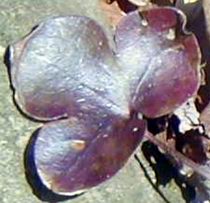|
Return to Hiker's Notebook Homepage
Common Name: Round-Lobed Hepatica, Liverleaf, Mouse-ear, Kidneywort Scientific Name: Hepatica americana (hepar is the Greek word for liver) Among the first harbingers of spring, Hepaticas emerge as soon as the temperature moderates. The flowers are characterized by a wide range of colors including white, lavender, pink and blue with three-lobed leaves at the base.
Potpourri:
The name hepatica is a result of
the Doctrine of Signatures, which
holds that the uses of a plant can be determined from some aspect of its shape
or in how it grows. The Doctrine was made popular in the 16th Century by a Swiss
physician who took the Latin name Paracelsus and traveled throughout Europe,
Asia and Egypt treating people with his concoctions.
The three liver shaped leaves of the hepatica were therefore believed
to invest the plant with healing powers for the liver, for which it was used.
Native Americans, having no knowledge of the Doctrine of Signatures or of the shape of the liver, had other uses for the Hepatica. The roots were used by the Chippewa after boiling them down into syrup to treat convulsions in children and by the Potawatomi to relieve the symptoms of vertigo. The Cherokee reportedly used it for "those who dream of snakes" by making a decoction of the herb to induce vomiting "after which the dreams do not return."
The ubiquity of the Hepatica has also made it the subject of Appalachian Mountain lore. According to one legend, a girl can win the love of any beau by sprinkling some powder made from Hepatica leaves dried by a fire over his clothing. |

